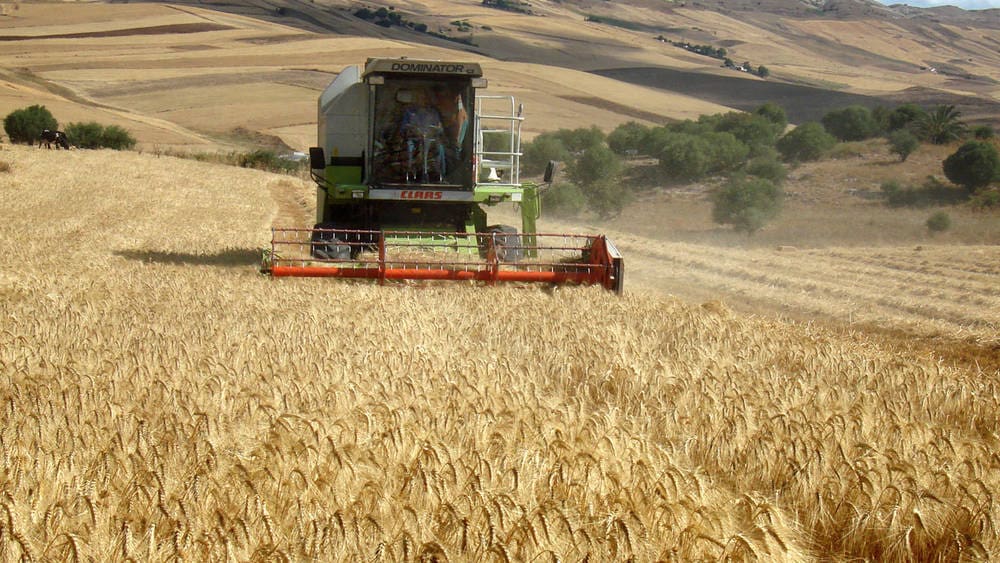
Harvesting wheat in Tunisia. Photo: ICARDA
GRAIN production in the North African countries of Morocco, Algeria and Tunisia has been severely impacted by one of the worst droughts in the past four decades, leading to an increase in regional imports to meet domestic demand requirements.
According to the United States Department of Agriculture (USDA), the North African region, which also includes Egypt and Libya, is forecast to overtake the Middle East as the world’s biggest importer of wheat in the 2020-21 (July-June) marketing year due to the decrease in production.
Domestic consumption in the region is expected to remain relatively static at around 47.1 million tonnes (Mt). However, production is forecast to be around 17.4Mt, down around 6 per cent compared with the
previous marketing year and 17pc lower than 2018-19.
Egypt
Consequently, local stocks have been run down over the past 12 months, and total wheat imports for the region are now forecast at a record 29.7Mt in 2020-21. This is an increase of 1.8Mt, or 6.5pc compared with the year t0 June 30, 2020. The increase is headlined by Egypt, the world’s biggest importer of wheat, which is predicted to buy in around 13Mt in 2020-21, below 13.3Mt in the current year, and 12.3Mt in 2018-19.
Wheat production in Egypt has not been affected by the drought afflicting the rest of North Africa, as a much higher proportion of the planted area is under irrigation. Harvest got underway last month, and it is expected to yield around 8.9Mt off 1.39 million hectares (Mha), an increase of 1 per cent and 5pc compared to the previous two seasons.
The Egyptian Government intends to buy around 3.6Mt of that production for its multi-million dollar food subsidy program. Egyptian farmers don’t like selling all of their crop to the state, preferring to store around half for their own use and selling some in their local souks.
Egypt’s domestic consumption is pegged at 20.8Mt in 2020-21, with the additional imports going to building up the country’s strategic reserves, a food security measure announced by president Abdel Fattah al-Sisi amid supply concerns due to coronavirus lockdowns.
Moroccan drought continues
Morocco is suffering its second successive year of drought, resulting in a sharp decrease in the area planted to cereals. The total harvested area is estimated at 3.8Mha, around 20pc below the five-year average. At 2.7Mha, wheat makes up almost three-quarters of the area.
Harvest started in May and yields are well below the long-term average. Morocco’s wheat production is expected to fall to 3Mt, down almost 27pc from last season and 49pc pc below the long-term average.
Moroccan wheat imports are set to hit a record 5.8Mt in 2020-21 as a result of the lower production, and its government has already taken the unusual step of exempting import taxes through the end of 2020. This is on the back of a sharp increase in 2019-20 imports to 5.1Mt, well above 3.7Mt in 2018-19.
Private importers in Morocco have led a push to double wheat inventories to six months of milling requirements by the end of October. According to Morocco’s agriculture ministry, five months’ worth of soft wheat and four months’ worth of durum had already been stockpiled by the end of last month.
Imports required
The regional drought has not affected grain production in Algeria as much as Morocco to the west and Tunisia to the east. Algeria’s wheat production is forecast at 3.8Mt, down 5pc from last season, but 23pc higher than the five-year average. Despite the relatively good season, Algerian wheat imports are forecast to rise 1Mt to 7.5Mt, around 4pc lower than the five-year average of 7.8Mt.
While wheat production of 1Mt in Tunisia is relatively close to the five-year average, it is down more than 31pc on last season’s bumper harvest. The country relies heavily on imports and is forecast to purchase around 1.9Mt of foreign wheat in the next 12 months. This is approximately 20pc higher than the current season imports, but only 5pc above the five-year average.
Environmental constraints limit the development of agriculture in Libya. Cereals are cultivated in the coastal regions where supplementary irrigation is possible. That said, wheat production is minimal, and the country is almost totally dependent on imports which are likely to total around 1.5Mt in the year to June 2021.
Tender activity
Grain tenders from the region have been slow in recent months, but purchases usually pick up after local harvests have been completed and new-crop export supplies come online across Europe and the Black Sea.
Egypt has issued two tenders for delivery in the 2020-21 marketing year, buying 120,000t of Ukrainian wheat on 2 June at an average price of US$220.65 cost and freight (C&F) and 120,000t of
Russian wheat on 10 June at an average price of $227.25/t C&F on 180-day deferred-payment terms.
Tunisia bought 25,000t of soft wheat last week after tendering for as much as 134,000t; it was purchased at $215.90/t C&F, $7/t higher than their April tender, and will most likely come from France.
Fillip for Australia
Last week’s USDA report was bearish for wheat with increased global production, despite the Russian crop estimate being unchanged, slightly lower consumption and record ending stocks.
Any increase in demand in the Mediterranean Sea region can only be good for Australian growers. This potentially means less wheat will be available to ship out of the Black Sea region into Australia’s traditional South-east Asian markets late in 2020 and in the first half of next year.

HAVE YOUR SAY